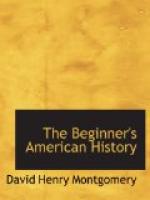[Illustration: The Palisades.]
Then, some distance further up, Captain Hudson came to a place where the river breaks through great forest-covered hills, called the Highlands. At the end of the fifth day he came to a point on the eastern bank above the Highlands, where the city of Hudson now stands. Here an old Indian chief invited him to go ashore. Hudson had found the Indians, as he says, “very loving,” so he thought he would accept the invitation. The savages made a great feast for the captain. They gave him not only roast pigeons, but also a roast dog, which they cooked specially for him: they wanted he should have the very best.
These Indians had never seen a white man before. They thought that the English captain, in his bright scarlet coat trimmed with gold lace, had come down from the sky to visit them. What puzzled them, however, was that he had such a pale face instead of having a red one like themselves.
At the end of the feast Hudson rose to go, but the Indians begged him to stay all night. Then one of them got up, gathered all the arrows, broke them to pieces, and threw them into the fire, in order to show the captain that he need not be afraid to stop with them.
[Footnote 2: Palisades: this name is given to the wall of rock on the Hudson, because, when seen near by, it somewhat resembles a palisade, or high fence made of stakes or posts set close together, upright in the ground.]
57. Captain Hudson reaches the end of his voyage and turns back; trouble with the Indians.—But Captain Hudson made up his mind that he must now go on with his voyage. He went back to his ship and kept on up the river until he had reached a point about a hundred and fifty miles from its mouth. Here the city of Albany now stands. He found that the water was growing shallow, and he feared that if the Half Moon went further she would get aground. It was clear to him, too, that wherever the river might lead, he was not likely to find it a short road to China.
On the way down stream a thievish Indian, who had come out in a canoe, managed to steal something from the ship. One of the crew chanced to see the Indian as he was slyly slipping off, and picking up a gun he fired and killed him. After that Hudson’s men had several fights with the Indians.
[Illustration: Captain Hudson on the great river.]
58. Hudson returns to Europe; the “Great River” is called by his name; his death.—Early in October the captain set sail for Europe. Ever since that time the beautiful river which he explored has been called the Hudson in his honor.
The next year Captain Hudson made another voyage, and entered that immense bay in the northern part of America which we now know as Hudson Bay. There he got into trouble with his men. Some of them seized him and set him adrift with a few others in an open boat. Nothing more was ever heard of the brave English sailor. The bay which bears his name is probably his grave.




